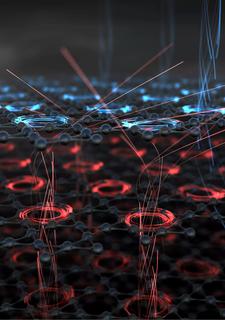ERC Starting Grant to explore the intrinsic orbital dynamics of Kagome superconductors
Chunyu Guo, group leader in the Department for Microstructured Quantum Matter at the Max Planck Institute for the Structure and Dynamics of Matter (MPSD) at CFEL in Hamburg, Germany, has been awarded a Starting Grant by the European Research Council (ERC) for his Free-Kagome project. He will investigate the novel effects of electronic correlations in the recently discovered AV3Sb5 family of Kagome superconductors using a sophisticated framework that isolates the samples from external influences and makes it possible to control them with extremely high precision.
The atomic structure of Kagome materials resembles the pattern of the Japanese basket weaving method which they are named after. A non-trivial electronic order may occur upon this lattice – a current orbiting within the unit cell, known as the orbital loop current. It is also responsible for setting the handedness of the chiral charge order and creating a magnetic moment. This results in a robust entanglement between the magnetic, electronic, and structural degrees of freedom and means that manipulating one order can affect or modify another, akin to the unique electromagnetic responses of multiferroics. It also renders the intrinsic characteristics inaccessible through conventional means, as even slight variations in experimental conditions can significantly affect the physical properties of these materials.
In his ERC project, Chunyu Guo will investigate the intrinsic orbital dynamics in Kagome materials using three different approaches: By atomically engineering the 2D Kagome nets, thermally quenching them to create 3D Kagome glass, and optically controlling the chiral domains via polarized light. Each step will provide unambiguous information about the intrinsic electronic orders in AV3Sb5.
Guo and his team bring unique skills to this research area due to their scientific background as well as their expertise in the use of Focused Ion Beam (FIB) technology. The FIB permits the ultra-precise fabrication of AV3Sb5microstructures. The samples are suspended via extremely soft springs carved out of thin silicon nitride membranes. This unique, force-free set-up permits a significant strain reduction of more than 99% compared to a conventional set-up. Without it, the material would show drastic changes due to residual strain, making it impossible to probe its intrinsic properties.
“In the past few years, we’ve dedicated ourselves to developing this technique,” says Chunyu Guo. “Now, thanks to the ERC Starting Grant, we can finally pursue the fascinating correlated orders in Kagome superconductors.”
The project team will be based in the Department for Microstructured Quantum Matter, led by Philip Moll, which was established at the MPSD in 2021. Its researchers investigate materials that display unusual electronic behavior, including Kagome structures.
Chunyu Guo obtained his Bachelor's degree (2014) and PhD in Physics (2019) at Zhejiang University in China before joining the Moll group at EPFL in Switzerland. In 2022 he moved to the MPSD with the group. The European Research Council (ERC) awards Starting Grants worth up to €1,5 million over five years to outstanding young researchers with a promising scientific track record.

